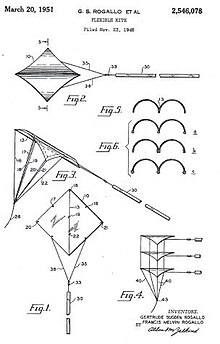Rogallo wing
They could not find official backing for the wing, including at Rogallo's employer National Advisory Committee for Aeronautics (NACA), so they carried out experiments in their own time.
By the end of 1948 they had two working designs using a flexible wing — a kite they called "Flexi-Kite" and a gliding parachute they later referred to as a "paraglider".
NASA briefly considered the Rogallo wing to replace the traditional round parachute for the Project Mercury capsule during temporary development problems.
Later, the Rogallo wing was the initial choice for the Project Gemini capsule, but development problems ultimately forced its replacement with the parachute.
[3][4] Nowadays the term "Rogallo wing" is synonymous with one composed of two partial conic surfaces with both cones pointing forward.
Rogallo had more than one patent concerning his finding; the due-diligence expansion of his invention involved cylindrical formats, multiple lobes, various stiffenings, various nose angles, etc.
Flexibility allows the wing to be less susceptible to turbulence and provides a gentler flying experience than a similarly sized rigid-winged aircraft.
Later in Australia John Dickenson[5] in mid-1963, set out to build a controllable waterskiing kite/glider, which he admitted adapting from a Ryan Aeronautical flex-wing aircraft.
Publicity from the Paresev tested-and-flown hang gliders and the various space contractors sparked interest in the Rogallo-promoted wing design among several amateur designersin: Thomas H. Purcell Jr., Barry Hill Palmer, James Hobson, Mike Burns, John Dickenson, Richard Miller, Bill Moyes, Bill Bennett, Dave Kilbourne, Dick Eipper and many others.
Much later Dickenson would do similarly as he fashioned an airframe to fit on the by-then standard four boom stiffened Rogallo wing.
Moyes went on to build a company with his own trade-named Rogallo wing hang gliders that used the trapeze control frame he had seen in Dickenson's and Australian manned flat-kite ski kites.
Today, most Rogallo wings are also controlled by changing their pitch and roll by means of shifting its center of gravity.
However, it developed a reputation for being unreliable, as it seemed prone to malfunctions on opening, possibly due to the unorthodox packing techniques for such a new design of canopy.
[citation needed] The Delta II was available until 1975 and paved the way for other Rogallo Wing skydiving canopies, such as the Handbury Para-Dactyl.
Mass-produced rogallo kites use a bridle that's a triangle of plastic film, with one edge heat-sealed to the central strut.



